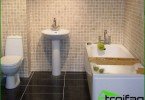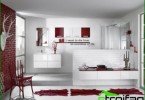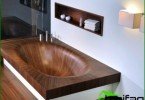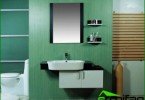Tiles for choosing a bathroom tile
The tile is a traditional finishing material for bathrooms. This happened mainly because the tile is not afraid of moisture. However, this is not his only advantage: it is also easy to clean, environmentally friendly, has low electrical conductivity, is characterized by high fire characteristics, wear resistance and durability. But no matter how good and popular tile for a bathroom – not everyone knows how to choose it correctly. But the tiles are different. Let us consider in stages, how does one tile differ from another, and what should you pay attention to when choosing it.
Content
- Choose the type of tile
- According to the manufacturing method
- According to destination
- According to the materials of manufacture
Choose the type of tile
According to the manufacturing method
The sellers need to clarify the method of manufacturing the tiles. This information will help determine the quality of the tile and its purpose. According to the manufacturing method, several types are distinguished:
1. Cast. It is made by casting and it turns out quite thick and uneven. Not suitable for bathrooms.
2. Obtained by extrusion – by far the most advanced technology in the manufacture of tiles. Its essence is that through a special “clay tape” and “mouthpiece” a raw material mass is stretched, which is then cut into lengths. The width / thickness of the products varies depending on the profile of the mouthpiece.
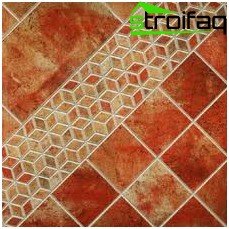
Extruded tile
3. Pressed. Most often used for flooring, as it has a low porosity. This is due to the fact that it is made under high pressure from a powder mixture with additives. Additives contain 5-6% moisture.
According to destination
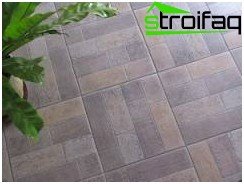
Pressed tiles are mainly used for flooring due to their high density.
All the necessary information about the purpose of the tile can be obtained by properly considering its packaging.
It is on it that various pictograms are usually placed that will help the consumer navigate.
1. Floor. Its thickness should be in the range of 6-9 mm. On the packaging of such tiles are feet. If the foot is located on a shaded background, it means that the tile has increased wear resistance.
2. Wall (9-12 mm thick). Her packaging depicts hands.
According to the materials of manufacture
1. From porcelain tile. It is non-slip, has a matte, rough surface, fits on the floor. Such a tile for the bathroom is good in terms of security. Also in this regard, ribbed materials with grooves for water win, but they are quite expensive..
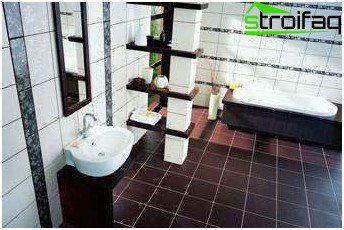
Porcelain stoneware bathroom looks presentable
2. Mosaic tiles. It belongs to the floor. It is durable, looks beautiful (especially when combined with large tiles) and is easy to fit.
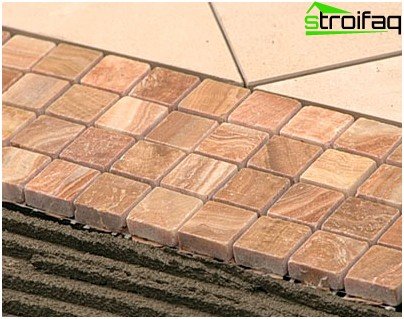
The combination of mosaic and regular tiles is a popular design technique with excellent effect.
3. Enameled ceramic tile. It is used for wall cladding. The enamel with which its surface is coated increases the protective properties of the tile, makes the tile shine, and is resistant to various hygiene products and detergents. However, this product is not durable, therefore it is suitable only for walls.
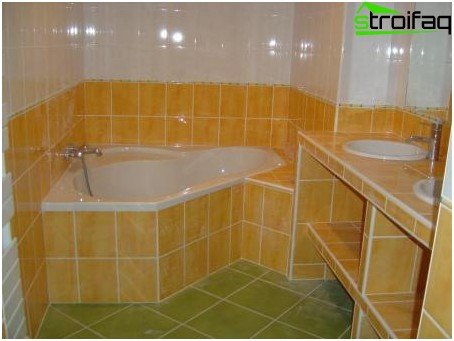
Enameled ceramic tiles – the ideal solution for cladding bathrooms, showers, pools
We determine the quality of the tile visually
Visually, you can determine the quality of tiles according to several criteria:
1. Plane. It is necessary to check the plane of the tile. It depends on her how difficult it will be to lay tiles in the future. Checking the plane is simple: to do this, take 2 tiles and lean them against each other with the front sides. The smaller the gap between them, the better the plane. You can also click on opposite corners, and then see if the tiles will “swing” one relative to the other. A gap of up to 1.5 mm is considered acceptable, and all that is bigger is no longer very good. The worst things are with the plane for commercial grades of graniteceramic.
2. Diagonal. It needs to be measured with a tape measure for several products at once. Best of all, if there is no difference, but if it is 0.5 – 1 mm, then this is also acceptable..
3. Glaze (only for glazed tiles). You should take a few pieces of tiles and inspect their icing against the light. It happens that in some batches of tile there is a defect: the glaze is covered with a network of tiny cracks, like a cobweb. This defect is always visible against the light, although during a routine inspection it may not be noticeable. In general, tiles with glaze defects (cracks, chips, etc.) are almost always found, the norm of marriage is considered to be 1 to 5 tiles per hundred. But they can only be seen when laying.

Feel free to comprehensively inspect the tiles when purchasing!
“Tiled” standards and specifications
Various technical standards and characteristics of tiles are developed in detail in many countries. There are certain standards systems. For example, in Germany it is labeled as DIN, in France as UPEG, in the UK as BS, in the USA as ASTM-ANSI, and in Italy as UNI EN. In Russia, there are various GOSTs, such as No. 6887-90 – as applied to floor tiles, also No. 6141-91 – for wall tiles, No. 13996-93 – as applied to ceramic facade. However, the norms most widely used are those developed by CEN – the European Commission for Standardization under the UNI EN mark. They are valid everywhere in Europe and in some non-European countries that accepted them, although they do not have legal force, but are rather of a recommendatory nature. However, if the UNI mark is on the packaging of the tiles, this definitely indicates its high quality.
One of the main technical characteristics of a tile is its wear resistance (abrasion). There are relevant standards for wear resistance, distributed in 5 classes, which differ depending on the purpose of the premises, even from the density of movement in them.
- Class I tiles are designed for places with little movement, where street shoes are not used (can be used as tiles for the bathroom).
- Tile class II is laid in places of movement of low density.
- Class III tile is used for floors of residential premises with medium-intensity traffic that do not have access from the street.
- Tile IV designed for public buildings.
- Tile V class is suitable for rooms with any intensity.
Choose the color of the tile
The color scheme of the tile can be any. It all depends on tastes, personal preferences, ideas that I would like to bring to life. Look through fashionable interior magazines, see how famous designers select tiles in the bathroom – the photo can tell a lot. We will also give you some useful tips..
We do not recommend experimenting too much. After all, a trendy tile in a couple of months may turn out to be irrelevant, and its extravagance in six months can also bother you. Give her preference only if the soul really lies in such a color, do not blindly follow fashion trends.
Always relevant ceramic tiles of classic design – pink, blue, white, green colors and their shades.
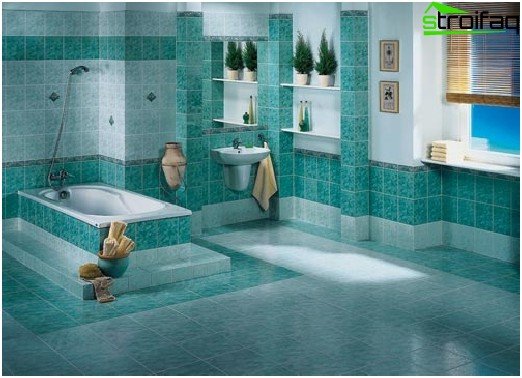
Tiled bathroom in classic color
If you like a tile of dark colors and shades, then keep in mind: on this tile you will see all soap stains, as well as splashes from the water, it will often have to be cleaned. If you like a mirror tile, then keep in mind that any small scratches and cracks are very noticeable on it. However, it will look very stylish in the bathroom, where metal accessories and associated furniture are installed..
Consider the design of the room. In a large bathroom, a small tile will look bad, it is better to purchase large tiles, and in a small one a small tile will do. In a modest room, tiles of bright colors usually look spectacular – it always contributes to a visual increase in space.
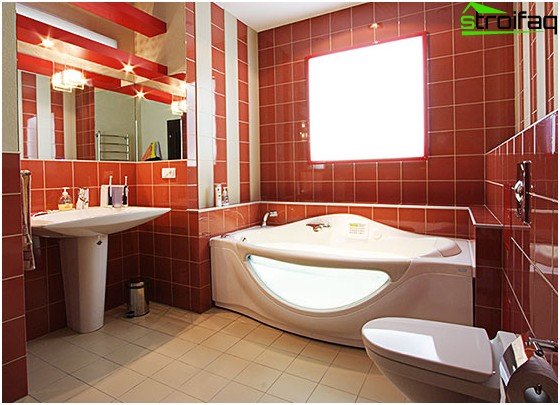
Tile colors that are too bright can tire
Be wary of tiles that are too bright in colors – orange, yellow, red. In the bath, they depress, do not let you relax, create a kind of crushing enclosed space from which you want to quickly exit. But in the bathroom we most often go for relaxing water procedures with the desire to relax after a busy day.
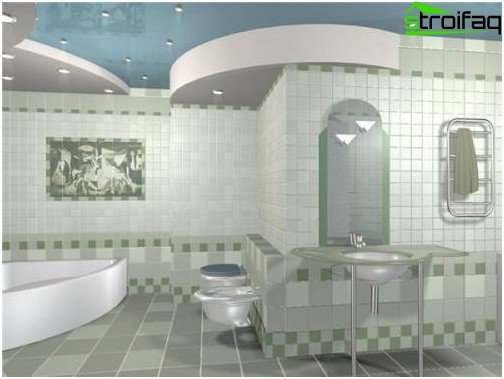
Make a significant accent in the bathroom – for example, choose a tile with an interesting pattern!
Tile in the bathroom – the photo of which is so often full of in fashion magazines of the interior, sometimes selected depending on the importance of this room for the owners. If the bathroom is one of the main rooms in which you spend quite a lot of time, then it is worth making some significant emphasis, for example, picking up tiles with beautiful drawings. If it’s secondary, then it’s advisable to draw in pastel colors, and if children spend the most time in it, then make it just white – then the kids will be able to paint the walls with washable markers.
Try to choose the tile for the bathroom competently, and then it will serve you long and reliable, delighting the owners with all its best properties.


